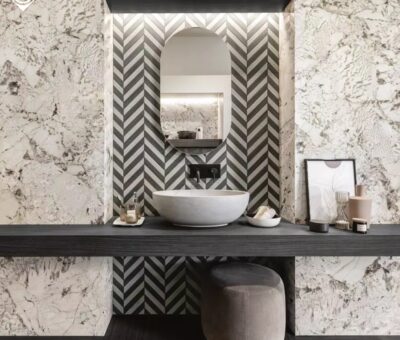Tile House: 5 Pro Tips For Choosing Tiles
The Tile House team have many experiences of the difficulties people go through when choosing tiles. To help customers out, the sales team put their heads together and came up with the five most important things to consider when choosing your tiles.
1. Area (sqm)
First, calculate the area that you want to tile. This seems simple, but it can actually be a bit tricky. Start by measuring the length of the room and the width of the room. Then multiply them by each other. Eg. 3m length x 2m width = 6 square meters. That gives you the “exact” amount of tiles you will need. However, when laying tiles there is always “wastage” due to cuttings and making the tiles fit into your space. Therefore, as a rule of thumb tile house suggest always including an extra 10% “wastage” on average. Using this example, the amount of tiles needed will increase to 6,6 square meters.
The size of the area that you want to tile, has a huge impact on the amount of money you will spend. First, the cost increases due to the larger amount of tiles needed. Second, the larger the area means that more grout (in bewteen the tiles) and adhesive (underneath the tiles) is needed. Thirdly, more labour and/or time is required to lay the tiles. This will increase your labour cost in your budget.
In short, the size of the area you would like to tile has a direct effect on the amount you will spend. So, work out your area at the beginning, and try not change it too much if you want to stick to your budget.
2. Budget
Second on the list is your budget. The tile house team views a budget as a filtering tool. It is hugely helpful and beneficial to know your budget upfront. Knowing your budget and the size of the area you want to tile, helps narrow down the range of tiles you can choose from. This is helpful, as there are so many tiles in many price ranges to choose from.
When considering your budget, the general rule of thumb is that the higher the tile quality, means the higher the price will be. John Almon, the founder of tile house always compares tiles to a motorcar, “if you want a Mercedes Benz, with an engineered body and designer finishes, then you have to pay for it”. Tiles are the same. The better quality tiles cost more due to research and development done by the manufacturers. Which affects the quality of clay used in the body of the tile, the quality of the glaze used on the tile, the quality control in the tile production process, and finally, the better “after sales” service by the manufacturers.
However, sometimes you don’t need an expensive tile for the application, and you can create a similar look with a cheaper tile option. Therefore, if you have a limited budget it is worth your while going to a reputable tile supplier. They will give you the right advice, and appropriate product for your application rather than purely trying to make a sale. They will always have a good selection of cheaper tile ranges, as alternatives to the more expensive tile options. A reputable tile supplier can assist you in achieving the look you want, without breaking the bank and ensuring a decent quality tile.
In short, good tile advice and a wide variety of tile price ranges will all help you to stick to your budget. As well as, reputable customer service from your tile supplier before and after the sale,
3. Application
Third, is understanding the space where you are laying you tiles. The most basic example is, “don’t use a wall tile on the floor”. The reason for this is that the wall tiles’ glaze is softer, and is not resistant to foot traffic. It is intended for wiping down for cleaning. A wall tile body is made up of a biscuit and a more porous clay. And, its glaze is not as hardwearing as floor tiles glaze. Whereas floor tiles are engineered differently, they will often be made with a mix of clays that are very hard, and are resistant to impact and abrasion.
The make-up of tiles is like baking a cake. Different recipes are used for different cakes, it is the same with tiles. A sponge cake is meant to be light, thus using more egg white. Whereas, carrot cake is meant to be chunky, thus using grated carrot and nuts. Tiles are the same, different clays are used for different outcomes. It depends on what you want to use the tile for.
The general rules are that floor tiles can be used on the floor and walls. Wall tiles can only be used on the wall. Indoor tiles need to be practical, easy to clean and not walked on when wet as they can be slippery. Whereas, outdoor tiles require anti-slip properties or anti-slip rating, as people will be walking on them when they are dry and wet. Tiles around a swimming pool are recommended to have an even greater anti-slip rating, as a precautionary measure.
In short, your tile supplier can provide great advice to help you decide in a tile which best fits your specific application. Make sure to ask them about the body make-up of the tile, its glazing, and if you need to consider an anti-slip tile surface.
4. Look & Feel
Fourth, consider the aesthetics you want to create. Decide on the colours and tones you want your tiles to be. This can be overwhelming, as there is so much choice! The tile house sales team’s number one tip is to gather a group of pictures from magazines or the internet which show the type of look and feel you want to achieve.
Bring photos of your existing space, as well as, images of what you want your new space to look like. Everyone sees colours differently. Thus, images help a sales assistant understand what you want, which will result in the best tile solution.
In short, do a lot of browsing in magazines and on the internet, and gather all the images you like. Then bring it all with you when you visit your tile supplier. The tile house team loves getting creative with clients! The team will lay out different tile options in the showroom over a cup of coffee.
5. Plan Ahead
Finally, try as best you can to plan ahead. This way, the tiles can be available for when you need them for your project. For example, many customers walk into our showroom and buy the tiles on “special”. This is a great bargain of course. But make sure that your floor plans or the tiled areas don’t change in the future. If you are currently building, the plans of your build might change, which means the quantity of tiles you need changes. You might end up with to too many tiles or too little tiles.
Another example is the potential shipping or transportation time for tiles that are imported. The rule of thumb is that imported tiles will take about two months from the order date to be delivered. However, tile house keeps majority of their tile products in stock in their warehouses. The tile house is able to hold tile stock, and only deliver it to a client when they need it. This means clients don’t have to store the tiles themselves, which can take up a lot of space.
In short, planning ahead will reduce your amount of “waiting time” for stock. It will help you stick to your budget, and ensure you have the right amount of tiles for your project.
Get professional help with your next project at the tile house.
You might also like...
-
Charmed Decor: Wadi Beige

Wadi Beige brings serene desert tones and gentle textures, evoking the tranquillity of sun-washed landscapes and soft earth beneath your feet. This soft-coloured tile is ...
-
Union Tiles: Go Bold with Statement-Worthy Splashbacks

This year, kitchen design is all about making bold, statement-worthy choices, and backlit backsplashes are taking centre stage. “These illuminated surfaces add a touch of ...
-
Sculpting Luxury: The Art of Fluted Marble & Granite

Design is evolving into a seamless blend of cultures, textures, and materials, where tradition meets modernity in the most captivating ways. At Sangengalo, the intricate ...




























